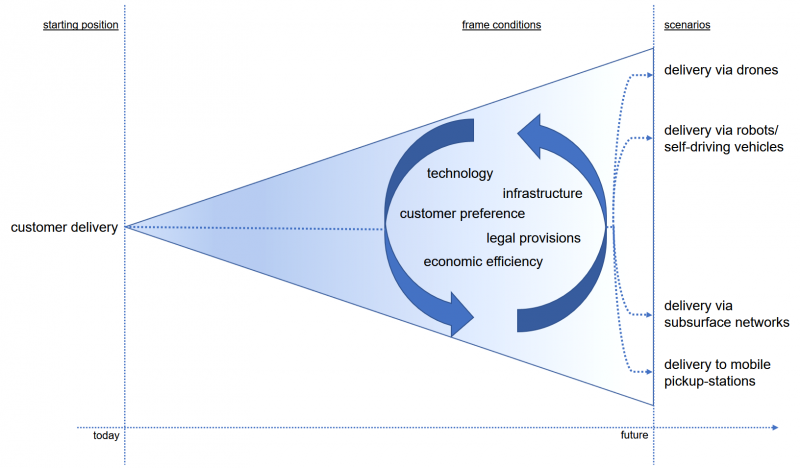Finding a balanced logistics mixture for solving the last mile problem in terms of city logistics
Artikel © Dominik Zielinski und Philipp Scheithauer (HS Flensburg, 2018)
Im Folgenden finden Sie einen Auszug der Arbeit. Für den Download des vollständigen Textes klicken Sie hier.
 Conceivable prospective scenarios dependent on certain frame conditions. © Zielinski, Scheithauer (2018)
Conceivable prospective scenarios dependent on certain frame conditions. © Zielinski, Scheithauer (2018)
1. Introduction
The megatrend urbanization says that people move from underdeveloped countryside to state-of-the-art, innovative metropolises. By the year 2050, 70 percent of the population on earth will live in cities.[1] Technological progress and towns that come to their limits of capacity cause new concepts like smart cities. In the context of logistics, new challenges as well as possibilities arise. Therefore, this term paper deals with the overall topic city logistics and its aims to improve efficient delivery in areas that are affected by high population density.
Increasing dynamics in economic competition and the arising relevance of e-commerce demonstrate the functionality of supply chains with a challenge. E-business gears to the needs of its customers to stay competitive. Individual handling of orders is complex and costly. The question is: how long can the suppliers hold the contemporary logistic systems up in terms of nearly fully stretched infrastructure? Consequently, nowadays concepts and alternative logistical methods should be tested for future viability. Main focus has to be on the last mile which describes the way of the final product to the end costumer due to its major influence on i.e. costs, environmental pollution, service quality and so on.
Accordingly, the goal of our term paper is to discuss the following research question: How can the last mile be optimized in view of future challenges in city logistics?
To deal with this subject, we give an overview of the status of literature concerning the novel issue of logistics in context of urbanization and the importance of last mile structure. Furthermore, we present our methodical approach that includes a cluster and scenario analysis based on actual state. After that, our aim is showing the most promising results to solve the last mile problem. First, we elaborate on different perspectives of the stakeholders which are retail, logistic service provider, consumer and local authority. Afterwards, we demonstrate practical guidance to improve the process of parcel deliveries. Finally, we discuss our findings and add the prospective considerations of our scenario analysis that are currently not implementable due to legal trouble. All in all, we suggest a multifaceted logistics mix which considers different feasible ways of transport.
[1] Tachizawa et al. (2015)
2. Actual challenges and new concepts for logistics
[...]
3. Methodical approach
[...]
4. Solving the last mile problem
[...]
5. Discussion
Specialize literature and numerous studies underline that trends like e-commerce or urbanization persist and force the pace. In 2015, 2.3 billion parcels were sent in Germany. That means 15 parcels per person per year. Within the next seven years, the Fraunhofer Institute predicts an almost doubling (4.2 billion parcels per year).[1]
A wide problem is the amount of failing delivery attempts of private customers. From the logistic providers’ point of view, it must be the purpose to increase highly the rate so that nearly every parcel is delivered. In doing so, redundant tours are avoided.
To achieve this objective, you can consider different approaches. In general, the goal must be to guarantee the successful delivery of every parcel, e.g. by using parcel boxes. The consequence would be emptier roads because multiple delivery attempts would not exist. Additionally, suppliers can establish an incentive scheme for customers to handle the subject e-commerce more consciously. Consumers must recognize that AHD is an auxiliary service almost on the cheap and the demanding attitude must change.
We want to amplify the awareness of a system composed of correlation that must be sustained over the long term. Mutual support is necessary. For example, the customer could take the pressure off logistic providers by picking up his orders at central pick-up stations on his deflection.[2]
A more radical way is to inspire the thought of fining recipients that are responsible for failed delivery attempts. We suggest the model of a first gratis try, if the certain delivery mode allows the principle of freedom from costs. Each further attempt would be debited with additional fees.
A not-negligible aspect concerning the last mile issue are the brick-and-mortars. Offline-retailers often are not mentioned in specialist literature dealing with the last mile problem in city logistics. But in our opinion, stated stakeholders bear co-responsibility for brick-and-mortars to design a more attractive appearance of urban areas. Local authorities should be mainly interested in reforging their districts. The mediation between customer and retail is an important task that comes up to communes.
In particular, it is the consumer who has a huge influence on the economic success of offline retailers due to its buying behavior. In practice, there are different models to unify offline and online retail by implementing omni-channel solutions to react to the customer’s wishes. The Online City Wuppertal is an example. Here the commune designed a special platform where local retail and logistic providers cooperate and interact channel-comprehensively. Consumers benefit by being able to purchase online as well as offline. They do not perceive a gap between the different channels because of the fluent passage, the lines between e-commerce and brick-and-mortars blur. The main aspect to disengage from giant suppliers like Amazon is the guarantee of same-day-delivery.
As a consequence, the need of reformation of offline retail shows oneself, even if this sector accounts for its own performance.
But what does the preceding section have to do with the last mile problem in city logistics? For us, a powerful offline retail provides the facility of relieving logistic providers. As already mentioned, DHL wants to dedicate the collection of parcels to demanders at the last kilometer. If the consumer makes use of brick-and-mortars, the individual fragmentation of goods is dropped, and the system of city logistics becomes unburdened provided by the customer.
In our opinion, the consciousness of the need of an innovative holistic system concerning city logistics in times of urbanization must increase. Therefore, we suggest a multilayer logistics mix comparable with the well-known marketing mix. It is not sensible to force particular technologies. We target an integral point of view. Solutions like e-mobility are pre-existing, although - properly speaking - each individual technology for itself does not make the last mile more efficient. Indeed, certain aspects (here: environment protection) are forced. Nevertheless, our main concern is the merger of all systematic components.
Therefore, we consult the three pillars of sustainability: ecology, economy and society. To achieve sustainable and complex goals, a profound logistics mix should be striven with the overall goal of efficient control of logistical transfer.
In general, you can notice five main ways of transport: railway, road, air, water or pipeline. We verify the exploitation of all feasible technologies to find the optimal mix. Thereby, you must consider a variety of parameters before implementing an overall solution:
- Costs and earnings (efficiency)
- Workload
- Flexibility
- Speed
- Environmental impact
- Danger of accidents
- Legal regulations
- Social acceptance
- Technical feasibility
- ...
Stakeholders, especially logistic providers and local authorities, must expedite and coordinate the expansion of necessary infrastructure. It is rather simple to pursue single topics. But if city logistics would be considered as a holistic issue of society, economy and ecology, it is not easy to operate the system.
In times of broad competitive constraints, it is important that investments in alternative delivery systems amortize in an adequate time frame. Therefore, the economy might entrust R&D with the task to evolve consisting technologies and to develop entire reliable new ones.
Concrete approaches for extending the existing system can be deduced of pre-existing technologies. We think about the exploitation of inner-city air space via the application of drones. The methodology is already proven, but you must consider legal barriers and the possibly missing acceptance provided by the customer. Challenges like coordinating the air traffic, security, capacity limits of parcel weight respectively size or implementing specific filed locations must be concerned.
Another idea is to rely on automotive delivery vehicles. As a first step, we propose small self-driving carts that accompany the deliverer on the sidewalk automatically. As a next level, the implementation of automatic vehicles that delivers the recipients independently can be seen. The customer could pick up his article using codes. The concept of Domino’s Pizza in Hamburg proves that the technology works.[3]
A further thought is the utilization of metro infrastructure for transportation of cargo at night. Nights, capacities are available to carry freight due to the lower clock of subways. That means that appropriate for shipping goods from stations to depots or trading centers must be established.
At the last mile it is necessary to be mindful of the type of transported goods. Thereby, you must yield to specific handling conditions like cooling or heating, extraordinary protection or special sizes like bulky goods or taller.
The deployment of infrastructure is rather costly, but even cheaper as the construction of freeways, whereby it must be mentioned that in compressed inner cities the space for new building is not available. In general, you must always evaluate whether an investment pays of in an appropriate period of time or not.
Albeit, pilot projects of management of city logistics have failed in the 1990’s in Germany, nowadays it is the only solution to deal with logistic challenges in urbanized areas. Today, technological possibilities are major eminent, and the need of innovation is much higher.
We are aware of the discrepancy between the current situation and the suggested system. The technology already exists, though. The implementation happens hesitantly due to giant effort and costs. The problem can be solved by cooperation of stakeholders instead of complete independency. Finally, there is no other possibility as shifting and redesigning urban traffic and logistic processes. Topics that are not fully stretched (pipelines, air space etc.) are of peculiar interest because of the high potential and in the same way because of high risk and uncertainty.
Nevertheless, we are starting out on these developments. Dimensions are hardly foreseeable. Now, the implementation of theoretical approaches is the next step in light of the danger that the current system cannot be maintained sustainably.
[1] FAZ (2016)
[2] Ehmke & Mattfeldt (2012)
[3] Handelsblatt (2017)
 Die Autoren
Die Autoren
Dominik Zielinski wurde 1994 in Osnabrück geboren. Im Rahmen seines dualen Studiums der Betriebswirtschaftslehre an der Hochschule Osnabrück absolvierte er den praktischen Teil bei der MÖLK Pressegrosso Vertriebs GmbH & Co. KG im Pressegroßhandel.
Philipp Scheithauer kommt ursprünglich aus Kiel, sein Geburtsjahr ist 1992. Er schloss im vergangenen Jahr sein Bachelorstudium der Betriebswirtschaftslehre an der Christian-Albrechts-Universität Kiel ab und ist seit September 2014 bei der WTSH im DiWiSH Clustermanagement beschäftigt.
September 2014 bei der WTSH im DiWiSH Clustermanagement beschäftigt.
Beide Autoren befinden sich derzeit im Masterstudium "Business Management" an der Hochschule Flensburg. Der vorliegende Artikel wurde im Rahmen des Seminars "Supply Chain Management" im vergangenen Wintersemester 2017/18 erstellt.
Kontakt
Dominik Zielinski
E-Mail: dominik.zielinski@stud.hs-flensburg.de
Philipp Scheithauer
E-Mail: scheithauer@diwish.de





Kommentare
Einen Kommentar schreiben